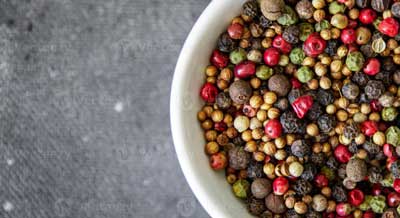
When most people think of pepper, they picture the classic black specks sprinkled over almost every savoury dish. Yet, walk down a spice aisle or browse a gourmet food shop, and you’ll find an array of colours — black, white, red, and even green. Among these, black, white, and red are the most common, but green peppercorns are also gaining popularity. Are they from different plants? Why do they taste so distinct? And which one should you use when cooking? This guide will not leave you guessing!
All true peppercorns — black, white, red, and green — come from the same plant: Piper nigrum, a flowering vine native to the Malabar Coast of India. The differences in colour and flavour don’t come from separate species but from when the berries are harvested and how they’re processed afterward. Pepper plants produce small round berries that grow in clusters. As they ripen, the berries change colour from green to yellow to red. Farmers pick them at various stages of ripeness to create different types of peppercorns, each with its own distinctive aroma, heat, and culinary use.
Black Peppercorns
Black peppercorns are the most familiar and widely used variety. They are made by harvesting the pepper berries just before they fully ripen — when they are still green but beginning to blush red. The berries are briefly boiled and then dried in the sun. This process causes the outer skin to shrink and darken, turning them black and wrinkled.
This method traps the essential oils inside, producing peppercorns with a strong, pungent aroma and a warm, woody heat. Black pepper’s flavour is complex — spicy, citrusy, and slightly earthy — making it a versatile seasoning for everything from grilled meats and stews to salads and even chocolate.
Black pepper originated in India, where it was once called “black gold” and used as currency during the spice trade. Today, it is cultivated across tropical regions, with major producers in India, Vietnam, Indonesia, and Brazil.
Freshly ground black pepper delivers the most intense flavour. Pre-ground pepper loses its aroma quickly, so using a grinder or mortar and pestle just before cooking makes a noticeable difference.
White Peppercorns
White peppercorns come from fully ripe red berries that are soaked in water for about a week. This soaking loosens the dark outer skin, which is then rubbed off, leaving only the pale inner seed. Once dried, the seeds become smooth, off-white peppercorns with a very different personality from their black counterparts.
By removing the outer layer, the drying process produces a milder, cleaner flavour with a hint of fermentation. White pepper still delivers heat but without the complex aroma of black pepper. It is slightly earthy and musky — a quality that some people love and others find less appealing.
White pepper is especially popular in European and East Asian cuisines. In French cooking, it is often used in cream sauces, soups, and mashed potatoes, where black specks would spoil the visual presentation. In Chinese cuisine, white pepper adds a gentle warmth to dishes like hot and sour soup or congee.
Because white pepper’s flavour comes mainly from piperine, the compound that makes pepper hot, rather than aromatic oils, it should be added toward the end of cooking to preserve its delicate taste.
Red Peppercorns
Red peppercorns are the least common and most visually striking of the three. They are made from fully ripened pepper berries that are harvested when bright red and then carefully dried without removing the outer skin. This results in glossy red or reddish-brown peppercorns with a fruity, slightly sweet heat.
True red pepper from Piper nigrum are rare because the ripe berries spoil quickly and require gentle handling. Many “red peppercorns” sold in shops are actually pink peppercorns, which come from a completely different plant species (Schinus molle or Schinus terebinthifolius) and have a light, floral flavour with little heat.
Authentic red peppercorns are grown mainly in Cambodia, India, and Madagascar, where the climate allows the berries to ripen fully before harvest. Their flavour combines the pungency of black pepper with a touch of sweetness and complexity, making them ideal for sauces, seafood, and gourmet seasoning blends.
Green Peppercorns
Green peppercorns come from the same plant (Piper nigrum) but are harvested earlier, while the berries are still unripe and green. Because unripe berries spoil quickly, they are either freeze-dried, air-dried, or pickled in brine or vinegar to preserve their fresh colour and delicate flavour.
Flavour-wise, green peppercorns are milder, fresher, and fruitier than black pepper, with a gentle heat. They are ideal for dishes that require subtle pepper notes without overpowering other ingredients. In French cuisine, for example, green peppercorns are famously used in steak au poivre vert (steak with green pepper sauce), as well as in creamy sauces, poultry, and seafood dishes.
A Matter of Taste and Appearance
The difference between black, white, red, and green peppercorns can be compared to coffee beans roasted to different levels — they all come from the same source but develop unique profiles through processing.
- Black pepper deliver boldness and warmth.
- White pepper provide subtlety and smoothness.
- Red pepper offer sweetness and depth.
- Green pepper bring freshness and a fruity, mild heat.

Each type showcases the versatility of a single plant. They also reflect centuries of trade, cultivation, and culinary tradition, demonstrating how harvest timing and processing can transform one fruit into multiple flavour experiences.
The next time you reach for the pepper grinder, notice how the choice of peppercorn can alter not only the taste but also the character of your meal. Pepper may be one of the most common spices in the world, yet within those tiny beads lies a spectrum of flavour that can surprise and delight.
One thought on “The Ultimate Peppercorn Guide: Black, White, Red & Green. Which one do you like the most?”